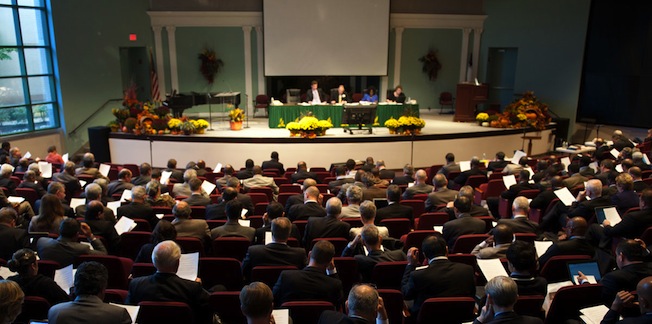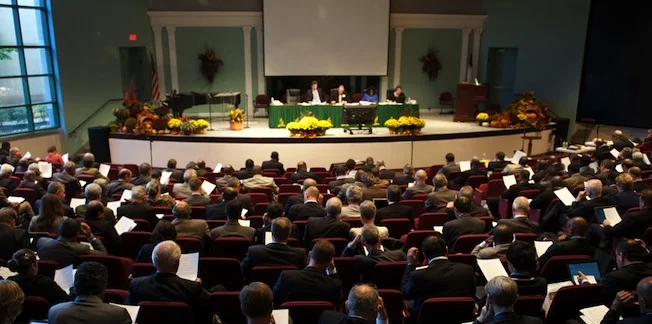Throughout my years in school, from junior high to graduate study, student government was one of my persistent passions. I was honored to serve as Student Association President at Loma Linda University during the final year in which my Master’s degree in systematic theology was finished. Too often, unfortunately, this particular arena of campus life has been maligned both as the province of frivolous popularity seekers and as a soapbox for the allegedly “troublesome young” who—in the words of the late U.S. Vice-President Spiro Agnew---dare to meddle in the grown-up world.
Read MoreAfter debate, Annual Council votes statement on church polity
 Following three hours of respectful study and discussion, leaders of the Seventh-day Adventist world church voted to approve a “Statement on Church Polity, Procedures and Resolution of Disagreements in the Light of Recent Union Actions on Ministerial Ordination” on October 16, during the Annual Council of world church leaders held in Silver Spring, Maryland, United States.
The vote was 264 in favor and 25 opposed.
Following three hours of respectful study and discussion, leaders of the Seventh-day Adventist world church voted to approve a “Statement on Church Polity, Procedures and Resolution of Disagreements in the Light of Recent Union Actions on Ministerial Ordination” on October 16, during the Annual Council of world church leaders held in Silver Spring, Maryland, United States.
The vote was 264 in favor and 25 opposed.
The move comes after three local unions – the North German Union in the Euro-Africa Division, and the Columbia Union and Pacific Union in the North American Division – separately voted this year to permit ordination “without respect to gender,” something the Adventist Church as a whole has twice rejected in votes at the movement’s General Conference Sessions, which are held every five years.
The voted statement expresses disapproval of the independent actions of the unions, appeals for all Church units “to consider thoughtfully the impact and implications of decisions” made independently of the world community, and affirms the role of women in the Church’s life and ministry. The document also points toward continuing studies on the theology of ordination, the results of which are expected to be ready in 2014, ahead of the following year’s 60th General Conference Session. No sanctions are applied, or suggested, in the document.
“This statement deals with Church structure and procedures. It does not address the question of ministerial ordination practices per se,” the statement said. “The central issue is one of Church polity – how the Church defines its organization, governance and operations.”
“Decisions to pursue a course of action not in harmony with the 1990 and 1995 General Conference Session decisions (with respect to ministerial ordination) represent not only an expression of dissent but also a demonstration of self-determination in a matter previously decided by the collective Church,” the statement said. “The General Conference Executive Committee regards these actions as serious mistakes.”
The statement text continues, “The world Church cannot legitimize practices that clearly contradict the intent of General Conference Session actions. … Accordingly, the world Church does not recognize the actions of unions or conferences that have authorized or implemented ministerial ordination without regard to gender.”
But the statement is also clear in stating the Seventh-day Adventist Church’s position on women: “The General Conference Executive Committee specifically affirms the important roles that women fill in the life of the Church. Their giftedness and commitment is a blessing to the whole Church and a necessary part of its work in mission.”
The measure passed on a secret, paper ballot after the day's discussion, which began with comments from Pastor Ted N. C. Wilson, Seventh-day Adventist world church president. Wilson expressed the hope that the world church's units would continue "focusing on the mission of the Church, uniting in Christ, even though we will face some differences and disagreements."
Wilson was followed by noted evangelist and retired General Conference vice president Pastor Mark Finley, who spoke about the question of how the early church made decisions and worked in unity. He referenced three incidents in the book of Acts.
"The essence of unity is not uniform action; it is respecting one another enough to listen carefully, respond thoughtfully and decide together," Finley said. "Insurmountable difficulties were resolved as early church leaders met together, prayed and surrendered their personal opinions to the decision of the larger corporate body."
During an extended comment period, Pastor Daniel Jackson, North American Division president, sought to reassure world church leaders that the division supported the Church's mission, despite the polity question discussed in the statement.
"We want to make it abundantly clear that the NAD without any hesitation expresses our unity with the world church," Jackson said. "We are not just an adjunct to the world church; we are brothers and sisters with every person in this room."
A pastor in the NAD’s Atlantic Union Conference, Dedrick Blue, told his fellow delegates that “the process deals with the mechanism, but the effect is just as important as the process. What we are grappling with here is the effect of our decision as a world body,” adding, “Don't get involved with process to neglect justice and mercy.”
While he voted in favor of the statement, Northwest Pacific Union Conference president Pastor Max Torkelson II said he hoped younger Adventists wouldn’t get the wrong message from the action. He spoke with a reporter following the meeting.
“I’m concerned that, particularly our younger church members have less patience” to wait for the world church to act, he said. “And we’re asking them, we have been asking them, for years, to be patient, and now again we’re asking them to be patient. I admire them to the degree that they are, but I’m wondering how long we can presume that they will be patient. I’m afraid that we may disappoint them.”
Following the vote and before prayers by Adventist university leaders from three continents, Wilson said he appreciated delegates’ careful approach to the matter.
“Thank you for your confidence in the power of the Holy Spirit to bring unity to God's Church,” Wilson said. “We're not at the end of the road, we still have a journey to complete, but by God's grace, let's do it together.”
By Mark A. Kellner/Adventist Review, and Edwin Manuel Garcia/ANN
—Click HERE to read the full statement (PDF download)
La Sierra University discovers errors in its reporting to US News education survey
 La Sierra University issued a response to the US News report, stating its average debt figure should be $42,934. La Sierra cited two major mistakes in its data preparation as the reason its average was reported much higher in the US News report. La Sierra had mistakenly included parent loans when US News had asked them to exclude them. Also, US News asked for only undergraduate debt, and La Sierra had included instances of loans secured by students moving directly into the graduate degree program.
La Sierra University issued a response to the US News report, stating its average debt figure should be $42,934. La Sierra cited two major mistakes in its data preparation as the reason its average was reported much higher in the US News report. La Sierra had mistakenly included parent loans when US News had asked them to exclude them. Also, US News asked for only undergraduate debt, and La Sierra had included instances of loans secured by students moving directly into the graduate degree program.
US News and World Report’s website published a report on September 12 indicating that La Sierra University students in 2011 graduated with the highest average debt load of any school in the country, according to 2011 figures. In reviewing student loan data used to develop the university’s US News survey response, La Sierra University uncovered two major mistakes in its data preparation on the debt load question.
The US News survey outlined a very specific set of parameters for universities to use to calculate the average graduating student debt. US News asked universities to exclude parent loans. La Sierra mistakenly included those loans in its calculations.
The university also uncovered a number of instances where loans that 2011 class members had secured to move directly into graduate degree programs were mistakenly included in the undergraduate loan total. US News asked participating institutions to include only undergraduate debt.
La Sierra University should have reported an average debt figure of $42,934 for the 119 La Sierra graduates who fit the US News criteria. This would drop La Sierra out of the US News top ten list of schools with significant debt burdens. La Sierra University’s own figures show that for the 2011 academic year, the average debt for the entire graduating class of 338 students was $29,363.
La Sierra University provides a large amount of institutional grant aid each year to help lower student costs. In 2011, that totaled $12.4 million. This means that, on average, the university covers 30% of tuition costs. In addition, financial aid counselors help students obtain federal and state aid. In 2011, our students received $7.2 million in Pell Grants and Cal Grants. Students received $4.3 million of assistance from sources external to the university, primarily through educational subsidies. Another $378,000 in aid came from scholarships, such as those set up by friends of the university through the Office of Advancement.
“We are deeply committed to helping every student who is admitted to La Sierra University find the resources to reach their educational dreams,” says Randal Wisbey, president. “We know that for many families, this is one of the largest financial investments they will make in their lifetime—and that it pays huge dividends. An important part of La Sierra’s mission is to serve students from economically stressed areas, such as the Inland Empire and across Southern California. We will sustain our efforts to make sure that we keep educational quality high and costs as low as possible for every student.”
La Sierra University is contacting US News and World Report with this additional information, and will work with the publication to correct its report.

